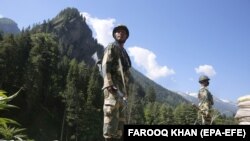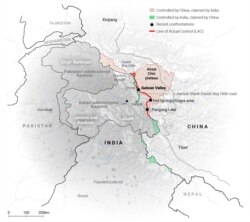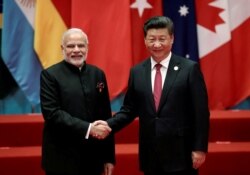A December 4 article in China’s state-run Global Times accused the United States of trying to “stir up regional conflict” between China and India by weighing in on border clashes in the western Himalayas between the two nuclear-armed states earlier this year.
The article was written in response to the release of the 2020 report to the U.S. Congress by the U.S. China Economic and Security Review Commission. Congress set up that body to inform the U.S. government about China’s activities on the global stage, including in matters of security, trade, politics and human rights.
The report states that "some evidence suggested” Beijing planned a massive June 2020 physical brawl involving Chinese and Indian troops in the Galwan River Valley, a disputed territory in eastern Kashmir.
Global Times cited a Tsinghua University academic who called the U.S. report “distorted,” accusing President Donald Trump’s administration of seeking to “exacerbate China's conflict with its neighbors to benefit the U.S.”
The article further blamed India for what were the most violent border clashes between the two countries in decades.
“The Galwan Valley clash broke out on June 15 between China and India’s border defense troops after Indian troops crossed the border and launched provocative attacks against Chinese personnel,” the Global Times claimed.
“A later statement by China’s Foreign Ministry suggested that Indian border troops should bear full responsibility for the clash, as they were the first to illegally cross the Line of Actual Control (LAC). They violated the agreement and made provocations, and breached international norms to launch attacks, the statement said.”
The claim that Indian troops instigated the fighting is misleading. No clear evidence of who or what sparked the incident has been made public by China, India or the United States.The fighting reportedly left 20 Indian and an unconfirmed number of Chinese soldiers dead (Indian media reported 43 Chinese fatalities). Those were the first deaths along the LAC since 1975.
China has consistently maintained that India is entirely to blame for the incident.
India’s External Affairs Minister, S. Jaishankar, told his Chinese counterpart Wang Yi in June that the skirmishes were a “pre-meditated and planned action” by China.
While saying the Chinese were at fault, the U.S. commission report does not specifically say who initiated the bloody hand-to-hand melee. Soldiers reportedly used clubs spiked with barbwire and rods as weapons. The combat took place in freezing temperatures at an elevation of 4,300 meters.
Video footage that the South China Post released, purportedly showing clashes between Indian and Chinese troops in the Galwan Valley, might actually be from an incident that happened in May, a military analyst told the paper on condition of anonymity.
The U.S. claim that China orchestrated the clash relies on publicly accessible circumstantial evidence.
For example, the U.S. commission said satellite images showed a large Chinese troop buildup in the Galwan Valley a week before the melee, “including potentially 1,000 PLA [People’s Liberation Army] soldiers.”
The report stated that the “proximate cause of the clash appeared to be India’s construction of a strategic access road to support troops” along the disputed border in the Kashmir region.
That satellite-related information came from Reuters and the Australian Policy Institute (ASPI), which analyzed pictures taken by Earth-imaging company Planet Labs.
ASPI said the Chinese military did not have positions in the valley before May of this year. It added that China’s decision to move as many as 1,000 soldiers into the valley was apparently prompted by “recently established Indian positions closer to the LAC, and the construction of a road to supply these positions.”
“Strategically, (Chinese) advances into the Galwan River Valley provide a superior vantage point for observing a supply route used by the Indian Army to reach its northernmost base, and the world’s most elevated airfield, Daulat Beg Oldi,” ASPI said.
Beijing also has been building up infrastructure along the LAC.
“China is constructing roads in the valley and possibly damming the river,” Jeffrey Lewis, director of the East Asia Nonproliferation Program at California’s Middlebury Institute of International Studies, told Reuters.
Beijing is also building the China-Pakistan Economic Corridor “in the critical Gilgit-Baltistan region where China abuts Pakistan and India,” and to the west of a contentious Indian road that runs “almost parallel to the border separating Ladakh from China’s Xinjiang province,” the South China Morning Post reported.
The U.S. commission further noted that during a panel discussion on the sidelines of the Chinese National People’s Congress (NPC) on May 23, Chinese Defense Minister Wei Fenghe said it was necessary to use “fighting to promote stability.”
However, he did not mention India.
The U.S. China Economic and Security Review Commission’s 2020 report cited a vague threat published in the Global Times, which warned that India “would suffer a ‘devastating blow’ to its trade and economic ties with China if it got ‘involved in the U.S.-China rivalry’.”
Since the incident, hostilities have risked boiling over again. In September, shots reportedly were fired for the first time in 45 years, contravening a 1996 bilateral agreement that banned the use of explosives and firearms within 2 kilometers of the LAC.
Unsubstantiated media reports surfaced claiming that China deployed so-called microwave weapons to reclaim territory seized by Indian troops.
The 1962 Sino-India war saw China redraw the LAC on its own terms, with Indian advances in the 1967 Nathu La and Cho La clashes further muddying the issue of sovereignty along the two countries’ Himalayan border.
A Chinese Foreign Ministry spokesman tweeted: “The Galwan Valley is located on the Chinese side of the [LAC] in the west section of the China-India boundary.”
India, for its part, says the LAC falls east of the contested portion of the valley.
"The position with regard to the Galwan Valley area has been historically clear. Attempts by the Chinese side to now advance exaggerated and untenable claims with regard to [the LAC] there are not acceptable. They are not in accordance with China's own position in the past,” India’s External Affairs Ministry spokesperson Anurag Srivastava said.
The U.S. commission called Beijing’s assertion of sovereignty over the entire Galwan Valley "a new claim and significant change to the territorial status quo.”







